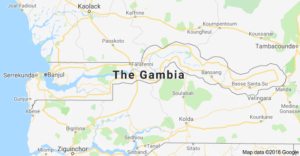
The GAMBIA
Located in the Western Africa, bordering the North Atlantic Ocean and Land boundaries with Senegal in total of 749 km Senegal having geographic coordinates: 13 28 N, 16 34 W.
Area: total: 11,300 sq km, land: 10,120 sq km and water: 1,180 sq km
Area – comparative: slightly less than twice the size of Delaware, USA
Climatic condition:
Tropical; hot, rainy season (June to November); cooler, dry season (November to May)
Terrain: flood plain of the Gambia River flanked by some low hills with mean elevation of 34 m, lowest point at Atlantic Ocean is 0 m and highest point is unnamed elevation 53 m.
Natural resources: fish, clay, silica sand, titanium (rutile and ilmenite), tin, zircon
Land use: agricultural land: 56.1%, arable land 41%; permanent crops 0.5%; permanent pasture 14.6%, forest: 43.9%, other: 0% (2011 est.)
Irrigated land: 50 sq km (2012)
Population – distribution: Settlements are found scattered along the Gambia River; the largest communities, including the capital of Banjul, and the country’s largest city, Serekunda, are found at the mouth of the Gambia River along the Atlantic coast
Population: 2,051,363 (July 2017 est.)
country comparison to the world: 146
Nationality: noun: Gambian(s), adjective: Gambian
Ethnic groups: Mandinka/Jahanka 34%, Fulani/Tukulur/Lorobo 22.4%, Wolof 12.6%, Jola/Karoninka 10.7%, Serahuleh 6.6%, Serer 3.2%, Manjago 2.1%, Bambara 1%, Creole/Aku Marabout 0.7%, other 0.9%, non-Gambian 5.2%, no answer 0.6% (2013 est.)
Languages: English (official), Mandinka, Wolof, Fula, other indigenous vernaculars
Religions: Muslim 95.7%, Christian 4.2%, none 0.1%, no response 0.1% (2013 est.
Legal system: mixed legal system of English common law, Islamic law, and customary law
The country faces a limited availability of foreign exchange, weak agricultural output, a border closure with Senegal, a slowdown in tourism, high inflation, a large fiscal deficit, and a high domestic debt burden that has crowded out private sector investment and driven interest rates to new highs. The government has committed to taking steps to reduce the deficit, including through expenditure caps, debt consolidation, and reform of state-owned enterprises.
GDP – composition, by end use:
household consumption: 87.2%
government consumption: 10.5%
investment in fixed capital: 20.1%
investment in inventories: -8%
exports of goods and services: 21.9%
imports of goods and services: -31.7% (2017 est.)
GDP – composition, by sector of origin:
agriculture: 20.4%
industry: 14.2%
services: 65.4% (2017 est.)
Agriculture – products: rice, millet, sorghum, peanuts, corn, sesame, cassava (manioc, tapioca), palm kernels; cattle, sheep, goats
Industries: peanuts, fish, hides, tourism, beverages, agricultural machinery assembly, woodworking, metalworking and clothing.
